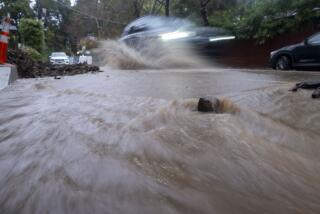Coastal Hamlet Keeps a Wary Eye on the Sky
- Share via
Lisa Leis surveyed the gathering clouds Tuesday as she gathered a few belongings for a quick trip out of La Conchita.
Forecasters warned that another storm was about to strike, and Leis knew too well what could happen to the unstable bluff that looms over the small coastal town in Ventura County. On Jan. 10, after four days of torrential rain, a large section of the bluff gave way, burying homes and killing 10 people.
“I’m scared,” Leis said. “We don’t want to take any chances. All the people who died in there we knew. The rains haven’t finished yet.”
The National Weather Service said that although the new storm lacked the intensity of the deluges that struck La Conchita, “any additional rainfall on nearly saturated ground and weakened hillsides could lead to a rapid onset of flash flooding, mudslides, debris flows and landslides.”
Water was still trickling down the hill Tuesday from the massive mound of brown mud that enveloped the homes. A sign warning of the bluff’s instability remained posted on the edge of town.
Leis loaded her Chihuahua and some clothes into her car and headed for the safety of a Motel 6 in Carpinteria, a few miles up the road. La Conchita resident Ernie Garcia, 78, motivated by the same concerns, made a shorter trip.
Garcia’s house stands right next to the pile of mud, and he decided to move temporarily to the home of a friend, about 20 yards down the street, where he felt a little safer.
“I think it’s going to be OK down here,” Garcia said.
Bill Harbison, 34, who lives on the east side of town, decided to stay put, but he spent the morning filling sandbags he used to build a shin-high wall around his home.
“It’s not going to stop the mountain, but it should stop the mud,” he said.
“I’m not happy about the weather report,” he added. “It’s not supposed to be that bad, but considering what happened before, I’m ready for a long, long drought.”
The weather service said the rain, which began falling across Southern California on Tuesday night, should be light but steady today, with about an inch expected in the coastal valleys and perhaps twice that much in the foothills.
Up to a foot of snow is expected above 7,000 feet in the Tehachapi, San Gabriel and San Bernardino mountains. The storm should move out tonight, with partly cloudy weather Thursday.
Another, weaker storm will bring a slight chance of light precipitation Thursday night, Friday and Saturday, the weather service said.
The San Bernardino County Board of Supervisors voted Tuesday to set aside up to $93.5 million to clear away loose dirt and debris from the 2003 burn areas that washed into catch basins.
Storms in December and January washed about 1.5 million cubic yards of gravel, mud and foliage into basins throughout the county -- the most amassed in the county in more than 30 years, according to public works officials. That much material could fill more than 90,000 big-rig trucks, county officials said.
Brush fires that charred more than 161,000 acres in October 2003 left soil on San Bernardino mountains and hillsides exposed and vulnerable to erosion.
The rains that followed carried the soil and debris into the basins, which are designed to trap solid material and prevent it from flowing into dams and flood control channels. If the debris washed into the channels, they could overflow, flooding streets and neighborhoods, public works officials say.
“We need to get this cleaned up because we don’t know what is coming later this year,” said county Public Works Director Patrick Mead.
Officials aren’t sure how the additional rain will affect a mysterious oil leak in Ventura County that has harmed thousands of seabirds found washed ashore from Santa Barbara to Huntington Beach, said Dana Michaels, a spokeswoman for the state Department of Fish and Game.
“The number of birds our capture and collection teams are finding are dropping,” Michaels said. “We’re still responding, but the numbers are diminishing. Maybe the oil’s dissipated or moved elsewhere.”
Officials say the heavy rains might have broken a pipeline or uncapped an abandoned well inland near the Ventura River, sending oil downriver to the Pacific Ocean.
Michaels said workers at the Oiled Bird Care and Education Center in San Pedro had taken in 1,188 birds since the oil was discovered Jan. 11. Hundreds of them died or were so contaminated they had to be euthanized.
Two oil-soaked California sea lions were taken Monday to the Marine Mammal Care Center in San Pedro to be cleaned and returned to the ocean.
*
Times staff writers Hugo Martin and Amanda Covarrubias contributed to this report.
More to Read
Sign up for Essential California
The most important California stories and recommendations in your inbox every morning.
You may occasionally receive promotional content from the Los Angeles Times.













